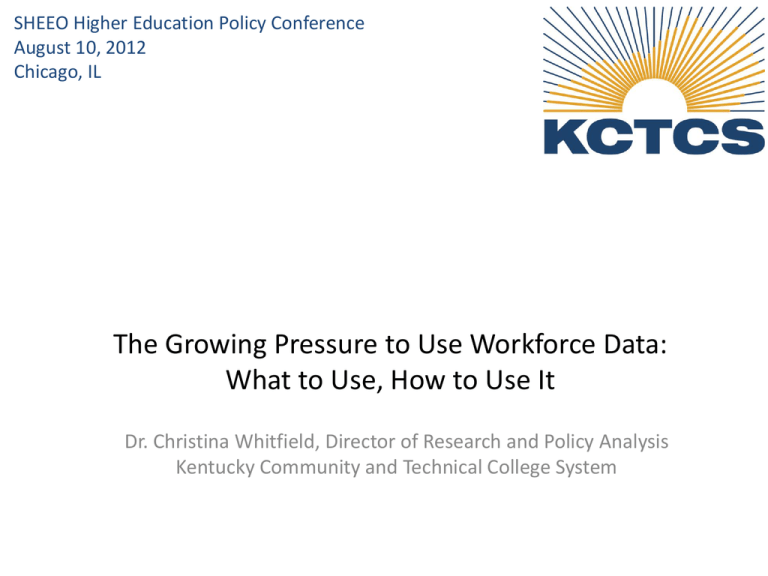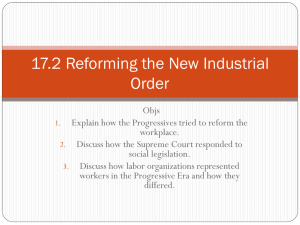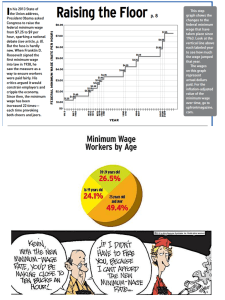Technical Considerations
advertisement

SHEEO Higher Education Policy Conference August 10, 2012 Chicago, IL The Growing Pressure to Use Workforce Data: What to Use, How to Use It Dr. Christina Whitfield, Director of Research and Policy Analysis Kentucky Community and Technical College System 45.0 KY 75th Percentile Wage Line -> Low Wage & High Demand 40.0 High Wage & High Demand Veterinary Technologists and Technicians Physical Therapist Assistants 35.0 Dental Hygienists Occupational Therapist Assistants 30.0 Cardiovascular Technologists and Technicians 2008-2018 Percent Change 25.0 Registered Nurses Medical Equipment Repairers Respiratory Therapists Medical Records and Health Information Technicians 20.0 Paralegals and Legal Assistants Biological Technicians 15.0 Life, Physical & Social Science Technicians, Other Computer Support Specialists Social Science Research Assistants Radiation Therapists Radiologic Technologists and Technicians Diagnostic Medical Sonographers Environmental Engineering Technicians Nuclear Medicine Technologists Environmental Science and Protection Technicians 10.0 Medical and Clinical Laboratory Technicians KY Average Percent Change Line Funeral Directors Civil Engineering Technicians 5.0 Computer Specialists, All Other Agricultural and Food Science Technicians Industrial Engineering Technicians Respiratory Therapy Technicians 0.0 Low Wage & Low Demand -5.0 Engineering Technicians, Exc. Drafters, All Other Chemical Technicians Fashion Designers Interior Designers High Wage & Low Demand Electrical and Electronic Engineering Technicians Broadcast Technicians Mechanical Engineering Technicians -10.0 $0 $10,000 $20,000 $30,000 $40,000 2010 Median Wage $50,000 $60,000 $70,000 $80,000 ACCOUNTABILITY KCTCS Strategic Plan High Wage, High Demand Completions 3,300 3,207 3,200 3,098 3,100 3,089 3,000 2,900 2,825 2,800 2,759 2,700 2,600 2,500 2006-07 2007-08 2008-09 2009-10 2010-11 Note: Number of unduplicated credentials in programs cross-walked to a high wage, high demand occupation. KCTCS Data Base, Kentucky Occupational Outlook to 2014, Office of Employment and Training Occupational Wages. KCTCS Strategic Plan Wage Index 100% 98% 95% 95% 92% 90% 88% 85% 85% 80% 75% 2005-06 2006-07 2007-08 2008-09 2009-10 Note: Median wage of KCTCS completers earning $2500 or more in the second quarter after completion, indexed to the state median occupational wage. Source: KCTCS Data Base, UI Wage Match, Office of Employment and Training Occupational Wages. Unemployment Insurance Match Rates by College 69% 59% 70% 62% 71% 70% 56% 74% 67% 74% 69% 67% 43% Note: 2010-11 completers, second quarter after completion. Source: KCTCS Data Base, UI Wage Match. 83% 69% 57% Policy and Practice Considerations • Impact of technical limitations of labor market information vary by institution • Institutions must partner with local economic development entities and employers • Many economic factors affecting employment outcomes are beyond institutional control CURRICULUM REVIEW Dynamic Skills Audit • A means to gauge education supply against employer demand • A methodology that incorporates traditional and real-time labor market information into a structured review of curriculum • A way to determine how responsive course content is to employer requirements Note: KCTCS is participating in a pilot project to develop Dynamic Skills Audits with Jobs for the Future. Dynamic Skills Audit: Labor Market Assessment DEMAND: Traditional LMI DEMAND: Real-time LMI SUPPLY: College & Employment Indicators ANALYSIS / ASSESSMENT Program of Study 2010-11 Ratio of Ratio of 2010-11 Job All 2011 No. of 2010-11 2011 Projected Graduates Placement/ Complet2011 2008 2018 10 Yr % Median 2011 2010 Students All Employed ions to Annual by Program Entered Jobs Jobs Jobs Change Annual Jobs Jobs by Completto 2011 Projected Openings (KCTCS) EmployWage Program ions Job Annual ment Postings Openings RN 2,440 2,163 2,634 21.78% 83 $54,401 298 175 160 65 81 82.1% 8:1 1:1 217 CMM 1,130 2,895 2,478 -14.40% 60 $37,000 1,534 683 28 20 46 63.6% 45:1 1:1 1,488 Job Postings minus Completions Note: Labor Market Assessment for selected programs at Owensboro Community and Technical College. 10 Dynamic Skills Audit: Skills Matrix Development Select Growth Occupation Gather Skills and Credentials from Employers Analyze Skills and Certifications Skills / Certifications Gap Analysis Compare Overlapping Skills Dynamic Skills Audit: Skills Matrix, Registered Nursing Real-Time LMI Skills Traditional LMI Skills Certifications Patient Care Social Perceptiveness Registered Nurse Organizational Skills Judgment Cardiac LS Spanish Mathematics Certified Rehab Source: Burning Glass, www.onetonline.org 12 Policy and Practice Considerations • Educational production one of many factors that may contribute to supply/demand mismatch • Allows institutions to test data against anecdotal experiences shared by employers • Requires a high degree of flexibility (how quickly can institutions respond to industry demands?) PROGRAM REVIEW Graduate Employment Profiles % NRG Employed Median Wage % NRG Earning $2500/Q Median Wage $2500+ Liberal Arts 60.7 $3,572 40.3 $5,100 Registered Nursing 81.4 $11,176 78.5 $11,277 Business Administration 72.3 $5,485 59.9 $6,158 Welding Technology 63.8 $5,313 50.0 $6,360 All 67.2 $5,306 53.8 $6,450 Note: 2009-10 graduates two quarters post completion. Source: KCTCS Data Base, UI Wage Match Graduate Employment Profiles ETA Common Measures Entered Employment Employment Retention 6-month Earning Increase Median Wage $2500+ Registered Nursing 70.7 90.2 $13,739 $11,277 Business Administration 40.5 92.2 $4,759 $6,158 Note: 2003-4 graduates. Source: KCTCS Data Base, UI Wage Match Graduate Employment Profiles Employment by Industry Registered Nursing 100% 7% Other Industries 93% Health Industries 90% 80% 70% 53% Other Industries 60% 50% 40% 30% 20% 47% Health Industries 10% 0% Date of Participation Note: 2003-4 graduates. Source: KCTCS Data Base, UI Wage Match 1st Quarter after Completion Graduate Employment Profiles Employment by Industry Business Administration 100% 90% 80% 70% 60% 11% Finance/Insurance 15% 50% 40% 25% Retail 23% Manufacturing 19% 30% 20% 10% 18% 0% Date of Participation Note: 2003-4 graduates. Source: KCTCS Data Base, UI Wage Match 1st Quarter after Completion Graduate Employment Profiles: Low Wage/High Demand Programs Cosmetology Child Care Provider Wage/Demand Quadrant LW/HD LW/HD % Employed 60 70 Median Quarterly Wage $3,080 $4,205 % Employed $2500+ 42 55 Note: 2009-10 graduates, second quarter past completion Source: KCTCS Data Base, UI Wage Match Policy and Practice Considerations • Programs with poor employment outcomes may generate revenue for the institution • Tenure and accreditation requirements may limit institutional ability to retrain and reassign faculty • Programs with poor employment outcomes may serve a social/community service function










